Unadon (Grilled Eel Rice Bowl) is a popular Japanese delicacy that you can easily make at home for lunch or dinner. This delicious unagi bowl features perfectly grilled eel fillets glazed with my homemade unagi sauce and nestled on a bed of hot steamed rice. The tantalizing aroma of the sweet caramelized glaze is enough to make your mouth water!
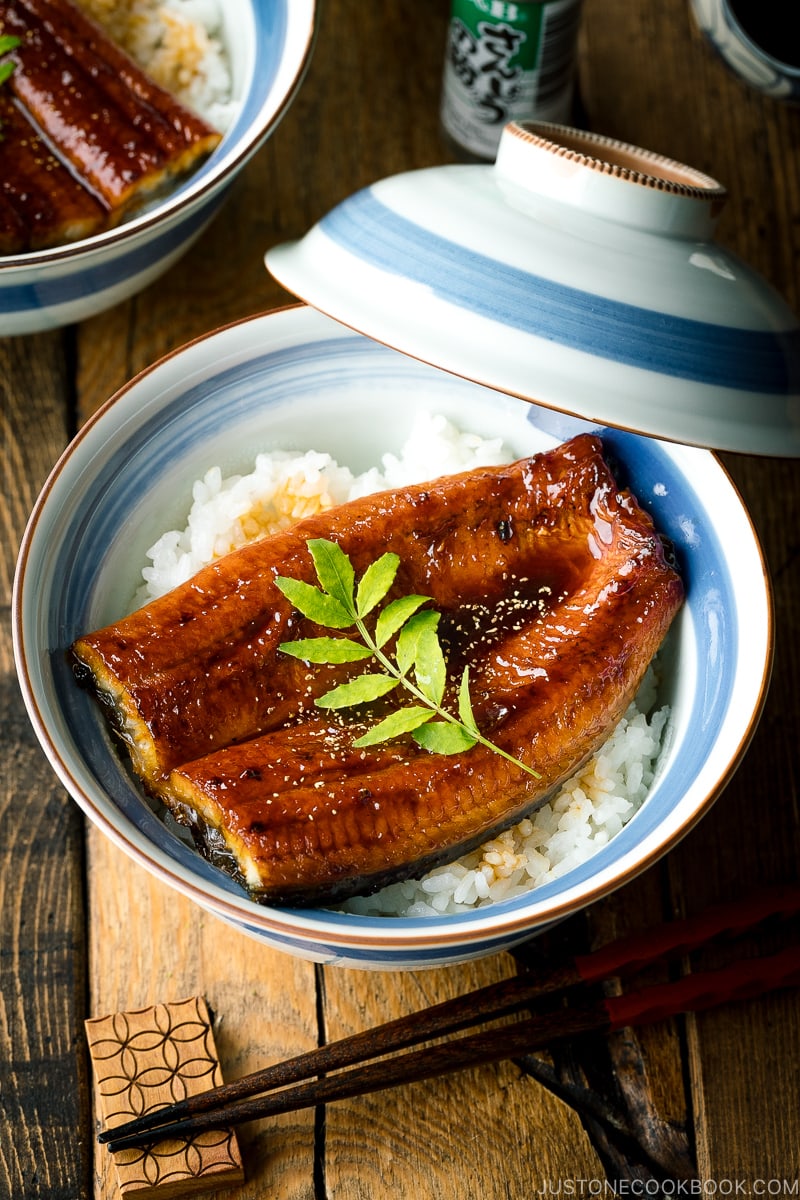
Unagi sushi is a mainstay item at most sushi restaurants, but have you tried unagi rice bowl before? This classic Japanese dish is called Unadon (鰻丼) or Unaju (鰻重), or you might have known it as eel rice.
The Japanese have a special affection for Unadon because the satisfaction of eating perfectly grilled unagi over a bed of warm rice is incomparable. Oh, and the aroma of the sweet caramelized sauce…that alone is enough to make my mouth water.
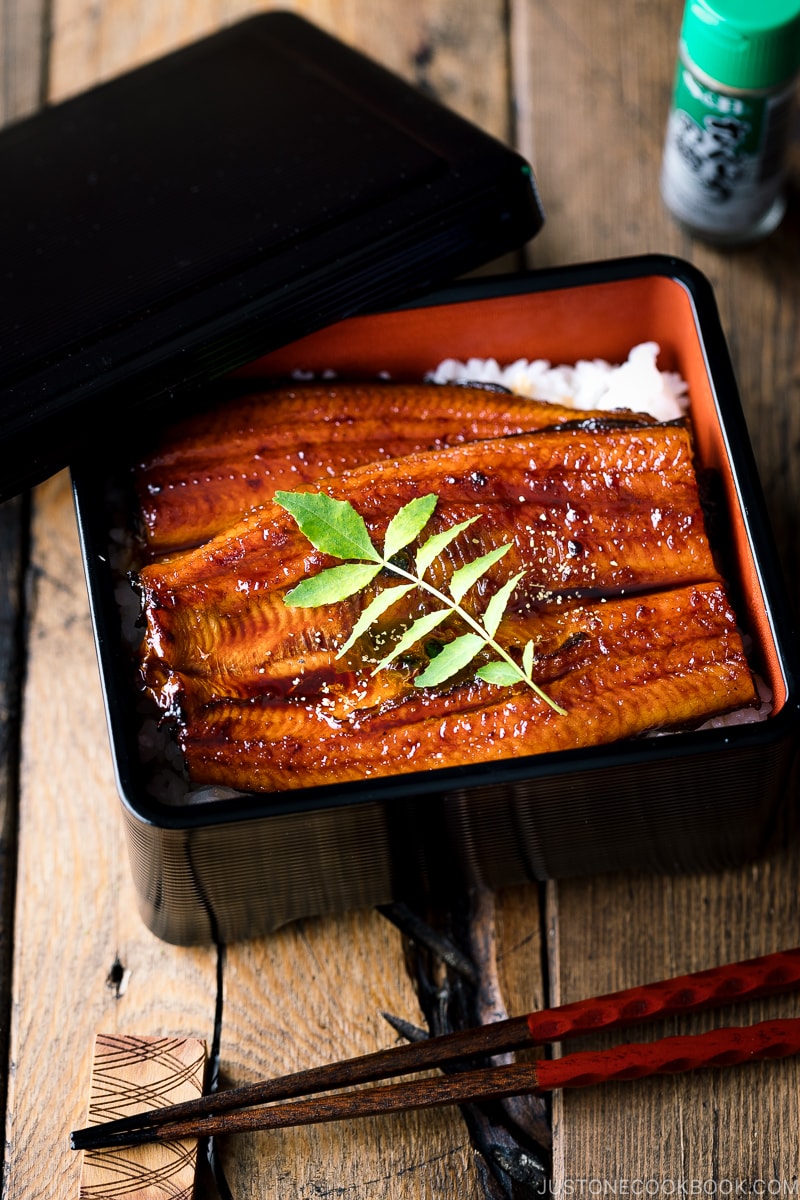
What is Unadon (Unaju)?
Unadon, or Grilled Eel Rice Bowl, is a beloved Japanese dish consisting of steamed rice topped with grilled eels glazed with a sweetened soy-based sauce (called tare) and caramelized, preferably over a charcoal fire.
When grilled unagi is served in a big rice bowl called donburi, we call it Unadon (鰻丼), a short for unagi donburi. When the unagi is served in a fancy rectangle lacquered box with the lid on, we call it Unaju (鰻重) because these boxes are called jubako (重箱).
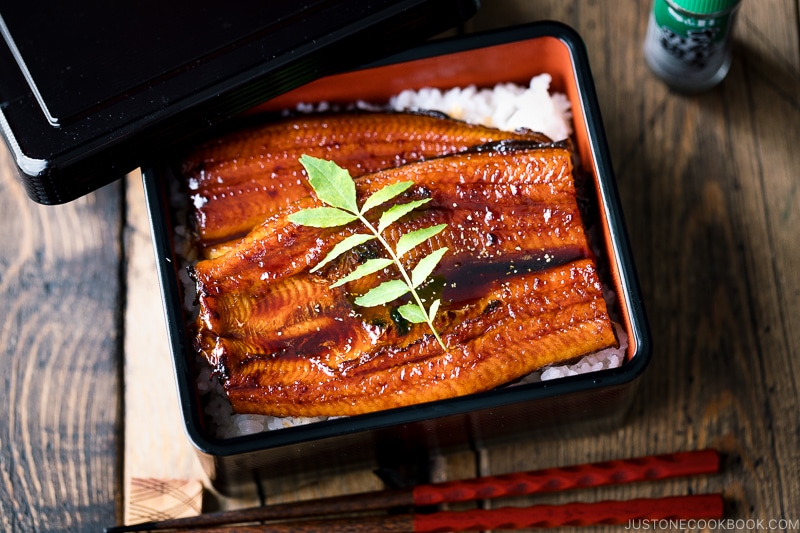
How Eels Are Cooked
This cooking method is known as Kabayaki (蒲焼), similar to Teriyaki. It’s a very common way to prepare eels and other fish in Japan.
This is how the unagi-specialized chefs prepare the eels. Live eels are split down the back (or belly), gutted and boned, butterflied, and cut into square fillets. Then, the fillets are skewered, dipped in a sweet soy-based sauce, and broiled on a charcoal grill.
In the Tokyo region, the skewered eel is first broiled without the sauce, and we call it Shirayaki (白焼き). Then the unagi is steamed before being dipped in the sauce and grilled again.
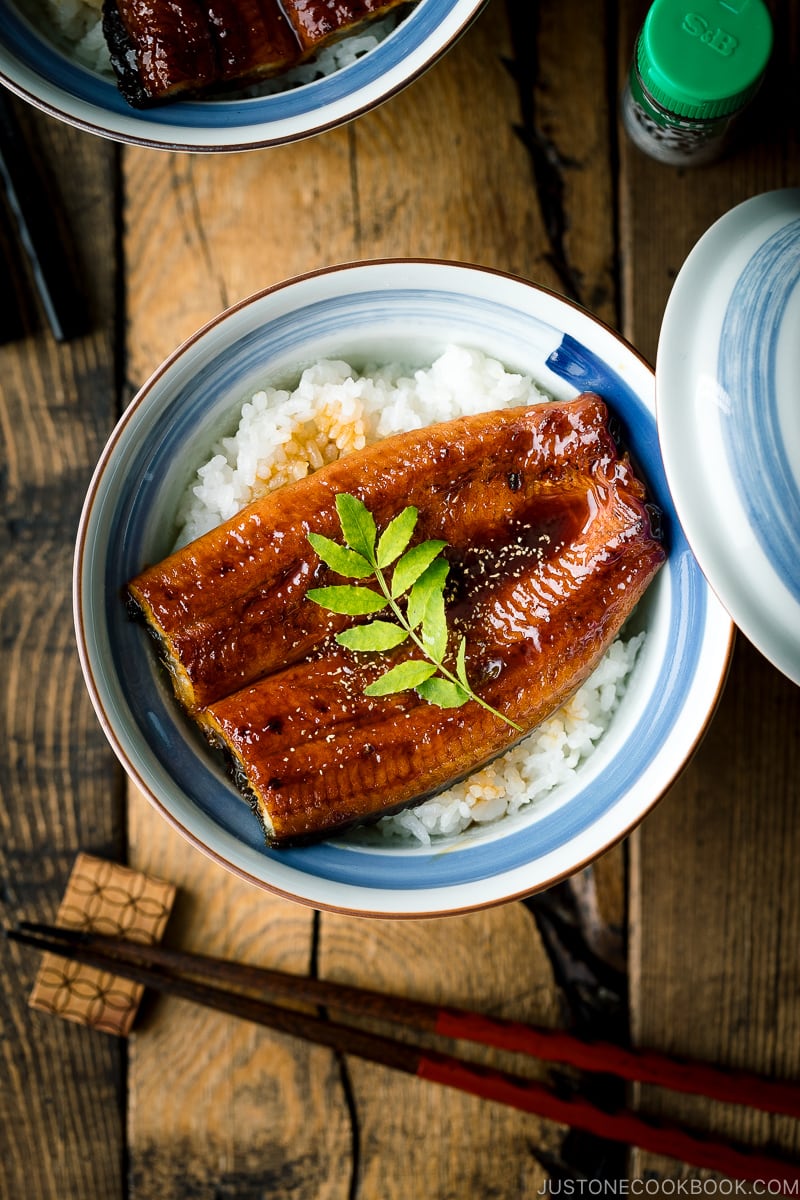
Dining at Unagi Restaurant in Japan
When you go to unagi specialized restaurants in Japan, the menu typically offers both Unadon and Unaju, and there are 3 ranks for the price whether you order Unadon or Unaju.
- The premium grade is called Tokujo (特上) or Matsu (松, pine)
- The superior grade is called Jo (上) or Take (竹, bamboo)
- The average grade is called Nami (並) or Ume (梅, plum)
According to the unagi restaurants, the price is usually related to the weight (amount) of unagi and not necessarily the quality.
Tradition: Eat Unagi on Mid-Summer Day
Unagi (freshwater eel) is considered an expensive delicacy in Japan, and it’s not an everyday dish. I did some quick research and found that 26.2% of people eat unagi “about once every 6 months,” followed by “once every 2 to 3 months” at 16.8%, “less than once a year” at 16.1%, and “once a year” at 15.8%.
So when do most people eat unagi? You will see big banners and carts of eel packages in the supermarkets right before the mid-summer day.
From the Edo Period (1600-1850), we have a tradition of eating unagi on a particular mid-summer day called doyō-no ushi-no-hi (土用の丑の日) to gain stamina to beat the heat.
- In 2024, it falls on July 24th and August 5th.
- In 2025, it falls on July 19th and July 31st.
Rich in vitamins A and E and Omega-3 fatty acids, the great nutritious benefits of eel are another reason why Japanese people enjoy eating unagi.
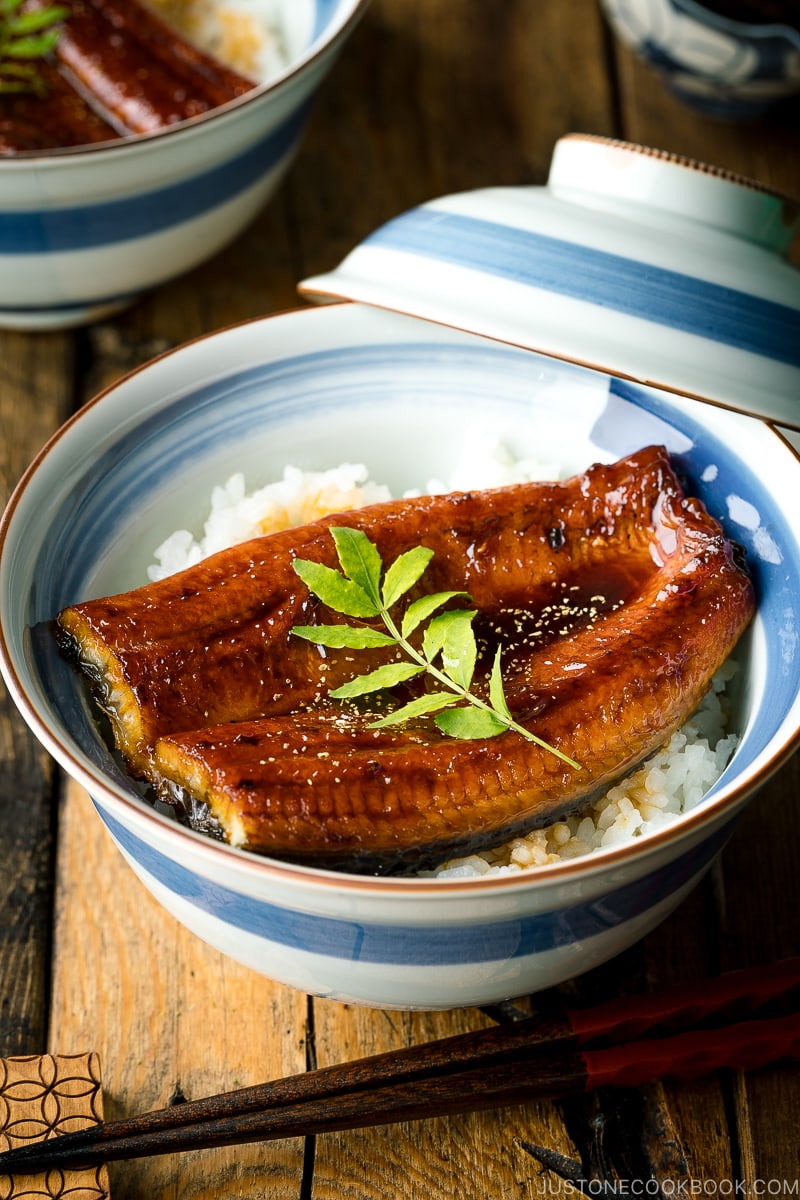
Ingredients You’ll Need
- Unagi (Eel) fillets
- Unagi sauce – you can get a bottle of eel sauce but it’s SO easy to make it at home (I’ll show you!)
- Steamed rice
Japanese home cooks don’t buy a live eel to cook at home. They buy pre-grilled eel fillets and just reheat them before serving. Here in the US, you can purchase grilled eels that have been vacuum-sealed in Japanese/Asian grocery stores or this online shop.
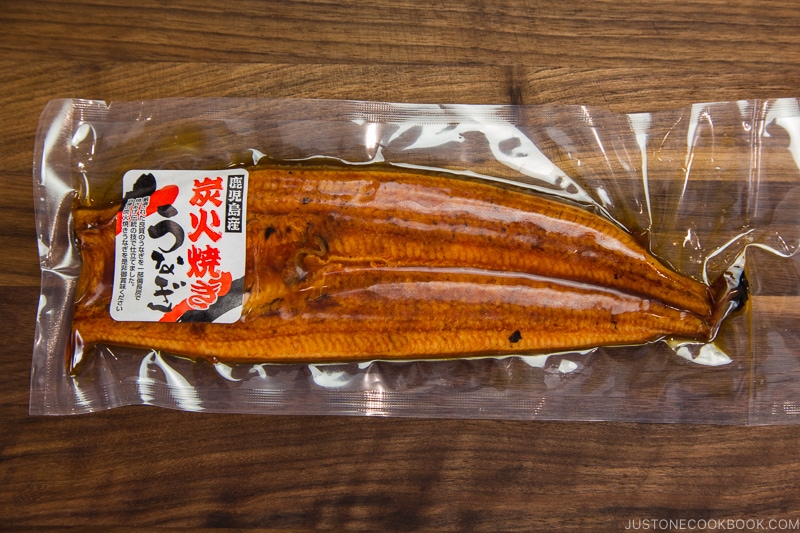
My local Japanese supermarkets sell imported unagi from Japan (all from Kagoshima prefecture) and they usually cost between $30-40 each (compared to the frozen eels from other countries, which cost around $10 each). If you are able to find Japanese unagi in your local market, you are in for a real treat!
How to Make Grilled Eel Rice Bowl at Home
- Prepare the homemade eel sauce (see below).
- Broil eel fillets and brush the eel sauce right before taking them out.
- Serve rice in a large rice bowl (donburi), brush with sauce, and serve eel fillets on top.
How To Make Homemade Eel Sauce (Unagi no Tare)
Today I will share how to prepare Unadon with my homemade eel sauce (unagi sauce). You can buy a bottle of unagi sauce at a Japanese/Asian market, but you can easily make it at home. All you need is soy sauce, mirin, sake, and sugar!
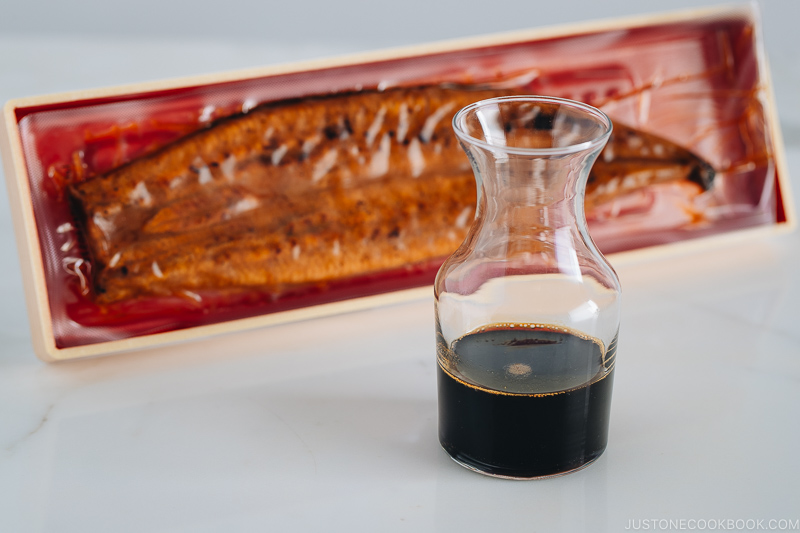
With just 4 ingredients, you can quickly whip up a sweet caramelized sauce to flavor the grilled eel. If I have any leftover unagi sauce, I’ll also use it to brush on my grilled rice balls to make Yaki Onigiri.
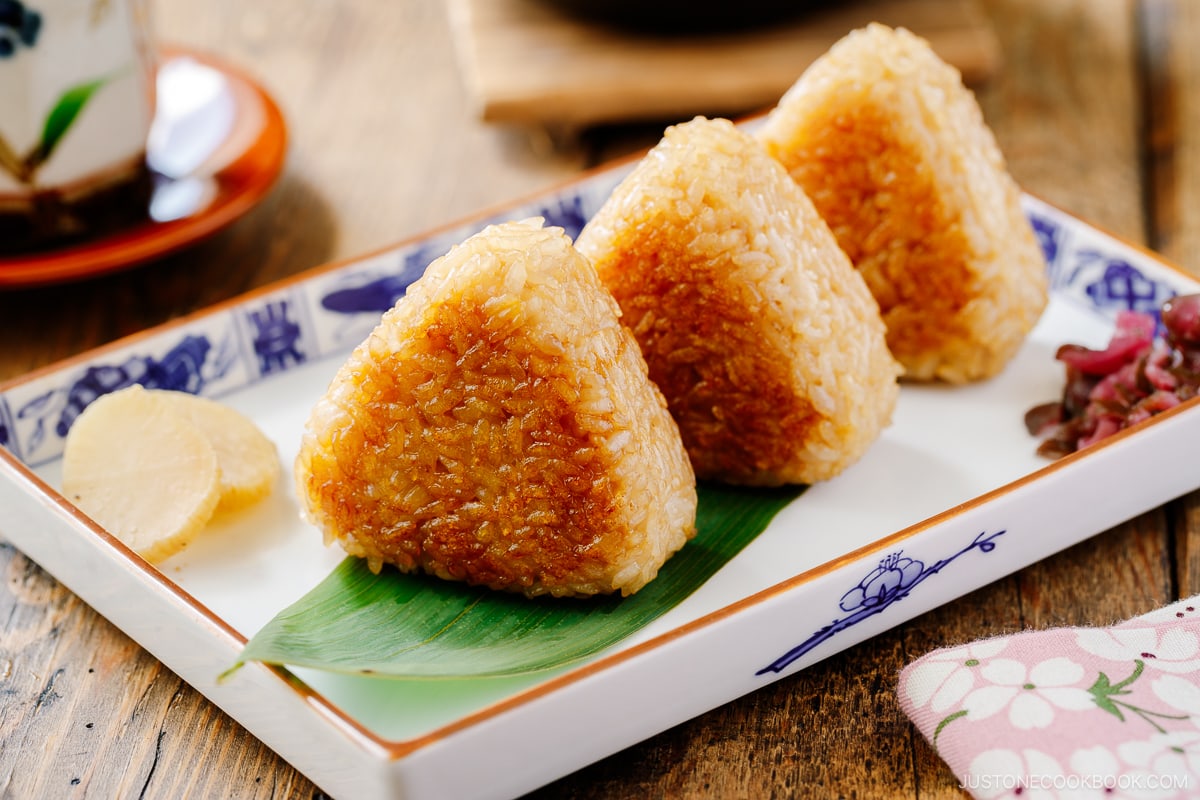
What to Serve With Unadon
You can serve it with miso soup, Japanese pickles, and small sides such as Spinach with Sesame Sauce or Kinpira Rekon.
Delicious unadon requires minimal effort to prepare, and it’s truly worth it to prepare this dish at home!
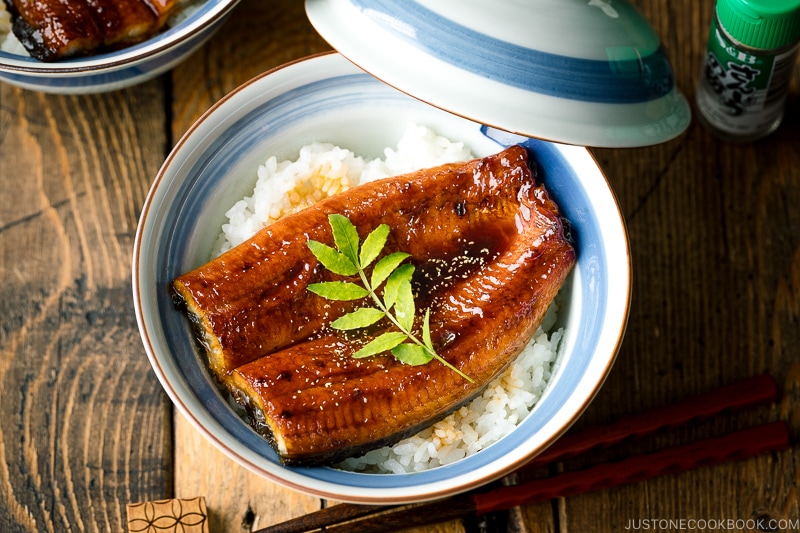
Wish to learn more about Japanese cooking? Sign up for our free newsletter to receive cooking tips & recipe updates! And stay in touch with me on Facebook, Pinterest, YouTube, and Instagram.
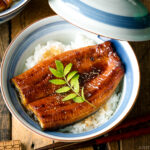
Unadon (Unagi Don)
Video
Ingredients
- 2 unagi (freshwater eel) fillets (one fillet is roughly 5.6 oz or 160 g; defrosted)
- cooking spray (or neutral-flavored oil, for broiling)
For the Unagi Sauce (double or triple the amount for extra sauce)
For Serving
- Japanese sansho pepper (optional)
Instructions
- Gather all the ingredients. Since the unagi sauce can keep for 3 months, I recommend making double or triple the amount for future unagi recipes or Yaki Onigiri.
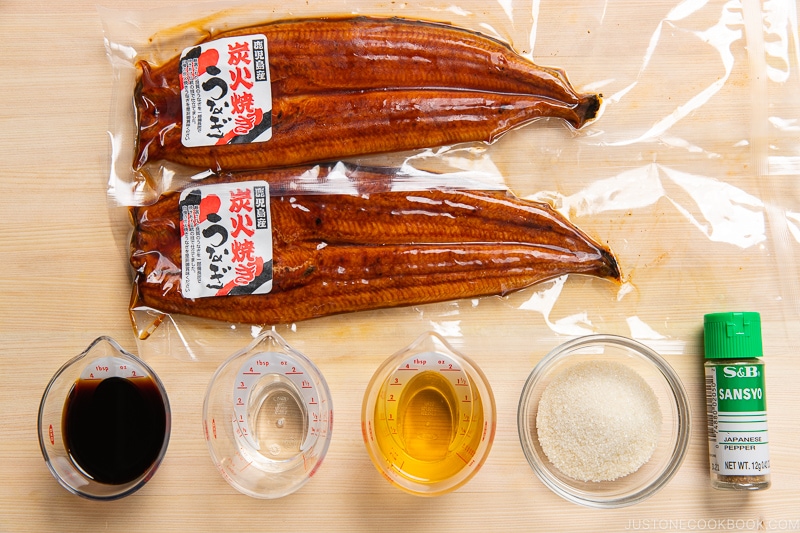
To Make the Unagi Sauce
- To a small saucepan, add ¼ cup mirin, 1½ Tbsp sake, and 2½ Tbsp sugar.
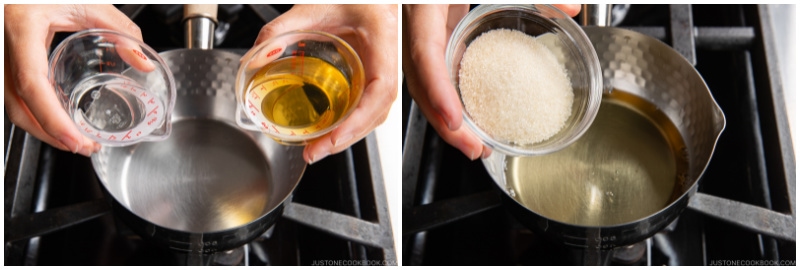
- Set the saucepan on the stove over medium heat and whisk the mixture together. Then, add ¼ cup soy sauce and bring the mixture to a boil.
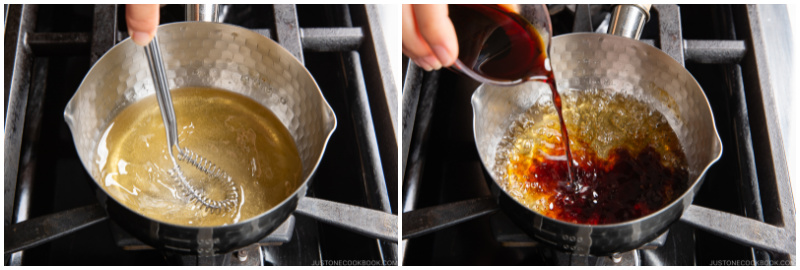
- Once boiling, reduce the heat to maintain a gentle simmer; you should see small bubbles around the edge of the pan. Continue simmering until the liquid is reduced to roughly one-third of the original amount, about 10-15 minutes. Tip: To check how much the sauce has reduced, dip the tip of a wooden chopstick into the liquid to mark the original amount; then, insert the chopstick again later to compare the sauce level against the original mark.
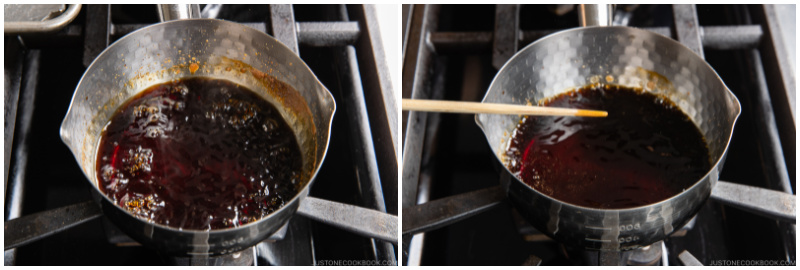
- Toward the end of cooking, the sauce will thicken and you will see more bubbles. Use the chopstick to confirm that the thickened sauce is one-third of the original amount. Then, remove it from the heat. As it cools, the sauce will thicken more. Tip: If you feel you've reduced it too much, add a bit of water to loosen up the sauce; you also can simmer it again a bit more to get the right consistency.
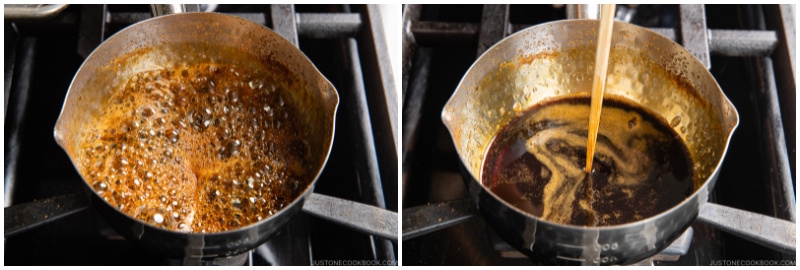
To Cut the Unagi
- Cut 2 unagi (freshwater eel) fillets in half or thirds to fit the size of your donburi serving bowl.
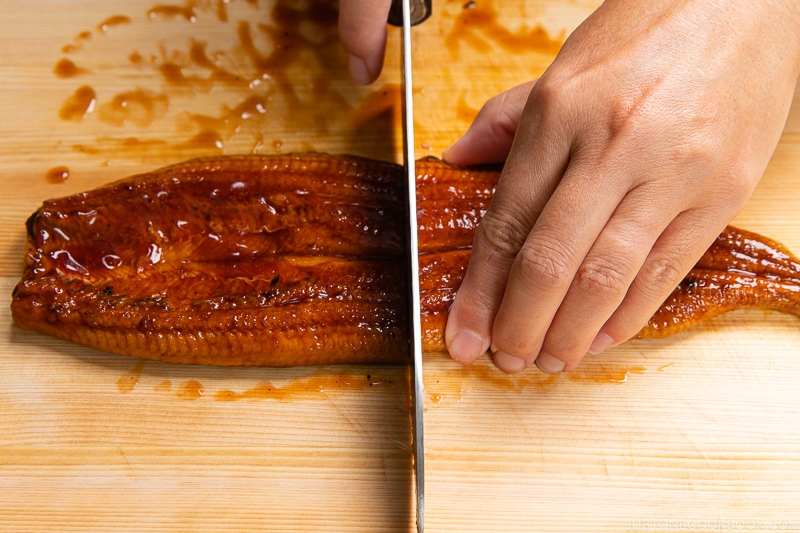
To Broil (recommended)
- Preheat the broiler* on High (550ºF/288ºC) for 5 minutes with a rack placed about 8 inches (20 cm) away from the top heating element (in the center of the oven). *The broiler settings are Low (450ºF/232ºC), Medium (500ºF/260ºC), and High (550ºF/288ºC). I usually broil on High (8 inches away) or Medium (6 inches away). When broiling, you don't control the temperature in the oven; instead, you control the distance between the broiler and the surface of the food. It's similar to using hotter and cooler zones on your grill.
- Line a baking sheet with foil for easy cleaning and brush or spray the oil onto the foil. Place the unagi pieces on the foil, skin side down. Broil the unagi until the surface is blistered a bit, about 5-7 minutes. Broil it on one side only; there's no need to flip it over.
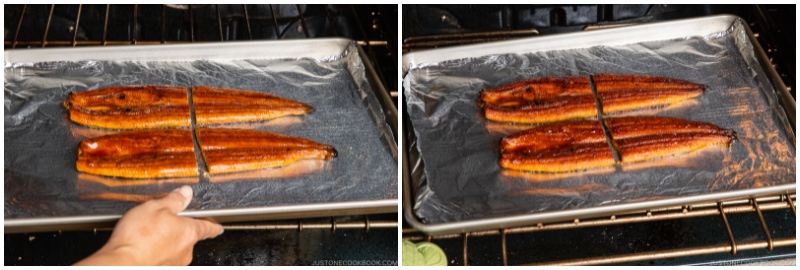
- Open the oven and brush the sauce on top of the unagi. Then, broil again for 30-60 seconds until you see the sauce bubbling on top.
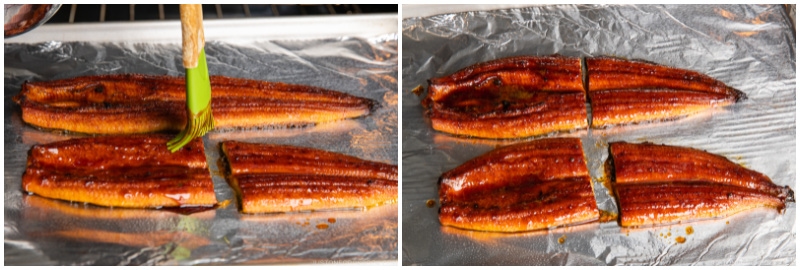
To Bake
- Preheat the oven to 425°F/218ºC with a rack placed in the middle position. Line a baking pan with parchment paper and place the unagi pieces on top. Bake until the surface is blistered a bit, about 10-12 minutes. Bake on one side only; no need to flip. Brush the sauce on top of the unagi. Then, bake again for 30-60 seconds until you see the sauce bubbling on top.
To Heat in a Pan
- Prepare two 16 inch x 16 inch (40 x 40 cm) sheets of aluminum foil. Thinly spread some cooking spray in the center of each sheet. Place two pieces of unagi on a sheet of greased foil. Bring the top and bottom foil edges together above the unagi. Fold and press the edges together a few times. Then, tightly close either side of the foil to form a sack. Repeat this process for the other unagi pieces. Add the foil pouches to the pan and reheat on low heat for 5-8 minutes. Tip: Your unagi won't blister or char if you use this method.
To Serve
- Serve the hot steamed rice in individual bowls. Then, pour or brush some of the unagi sauce on top of the rice.
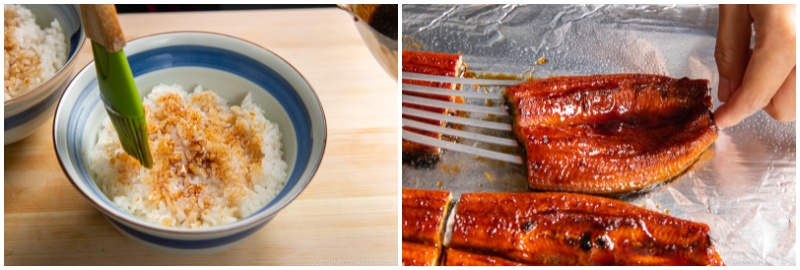
- Next, place one portion of the unagi on the rice in each bowl. Pour or brush more sauce on top of the unagi. Since I had a kinome (Japanese sansho pepper leaf), I placed it on top for garnish (optional). Serve immediately. You can also sprinkle ground Japanese sansho pepper on top (optional).
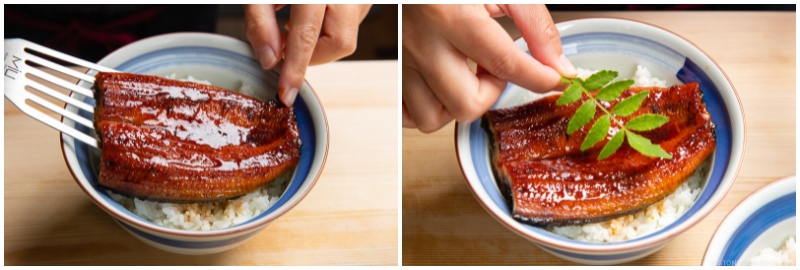
- To serve in a jubako (Japanese lacquered box), place a bed of hot rice in the box and brush some unagi sauce on top. For each serving, place 2 pieces of unagi (the entire fillet) on top, with the pieces overlapping each other and covering the rice. Brush more sauce on top of the unagi pieces and serve.
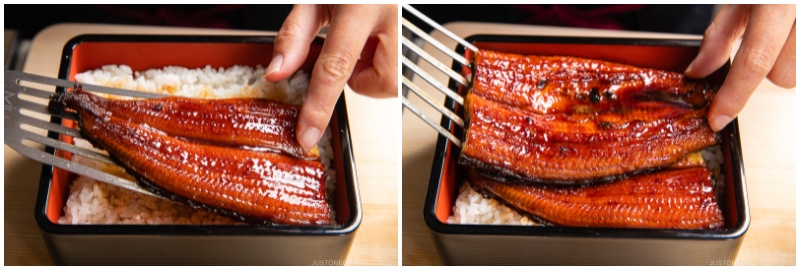
To Store
- You can keep the leftovers unagi in an airtight container and store it in the refrigerator for 3 days or in the freezer for 2 weeks. You can store any leftover sauce in an airtight jar and keep in the refrigerator for up to 3 months. You can use it to brush on grilled rice balls to make my favorite Yaki Onigiri.
Notes
Nutrition
Update: The post was originally published on May 31, 2012. It was updated with a revised recipe in July 2012. It was updated with new images and more helpful content on July 21, 2021, and republished on July 24, 2024.
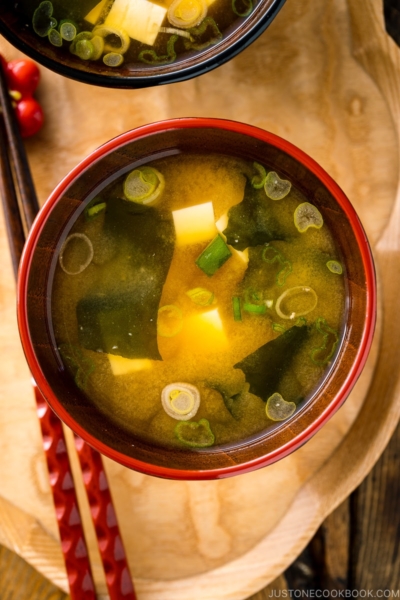
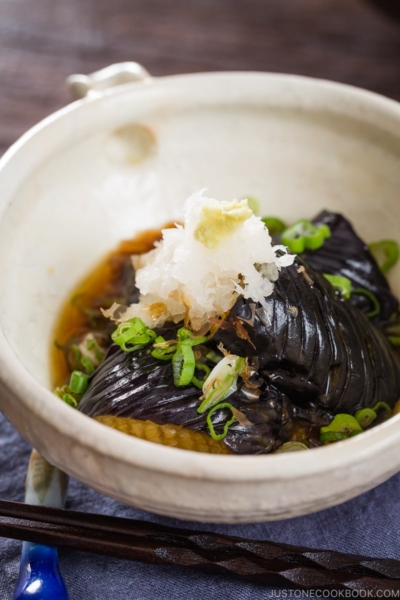
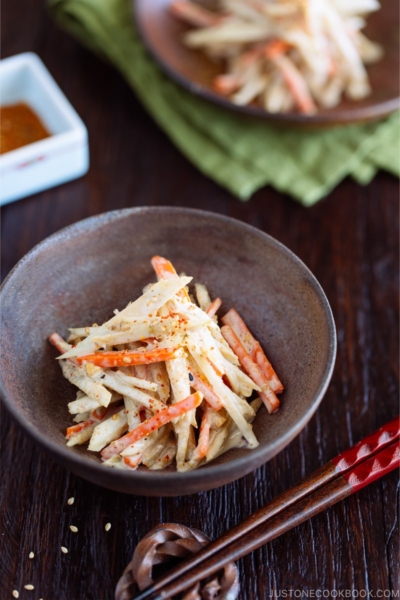
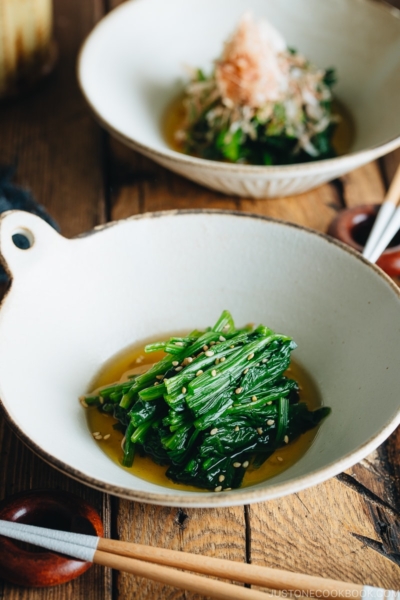





Hello,
I love all your recipes!!!! When I worked @ Ninja Japanese restaurant in Nola the chefs would put eel filets in the toaster oven skin side up to make the skin crispy. I’ve had an eel box from wholefoods and the skin was very chewy. Do you recommend I put my eel filet skin side up when broiling it?
Hi Lee! Be careful when you do skin side up. Make sure the flesh won’t stick to the toaster oven tray. If the eel stays on top of the wire rack, it’s less likely that it will stick but if it’s on the tray, be careful. If you include the skin to sushi roll etc, you can broil it separately too after you remove the skin from the fish. I cook father just for the skin etc for salmon as it needs to cook further more after fish is done cooking. Hope this helps!
hi nami,
I could only find already marinated unagi, do I follow the same steps as you?
Hi Fen! So sorry for my late response. Yes, all the unagi sold at the store is grilled and brushed on top with the sauce. 🙂
hi nami,
thanks for your reply 🙂 so do u mean I can remove those sauce & make my own sauce using your recipe instead?
thanks!
Hi Fen! You don’t need to remove the sauce as the sauce is not that much to begin with. But it gets burn easily when you grill, so if yours have too much sauce, just gently brush off and start grilling. You can use the sauce that you brushed off or make your own sauce to apply toward the end of cooking. I like extra sauce so that I can apply over rice too (that’s how Unagi restaurants do). Hope this helps!
Wonderful easy recipe! Made for a quick and delicious lunch. I did have a couple of questions about it.
The frozen eel I got had a whole lot of soy sauce/corn syrup/other stuff mixture on it, so I blotted most of it off with a paper towel before broiling. Would you recommend doing anything different with the eel?
I love how easy this dish is, but eel is a bit expensive, so I was wondering if there was any other kind of protein that would work well for this. I thought of tilapia, or some other fish. The only problem is that I’m not sure what the best way to cook it would be. The precooked eel is definitely the easiest I can think of.
Great recipe, and a rainy day food too! For some reason, eel just puts me right to sleep.
Thank you Jonathan! I usually buy unagi that is from Japan (not vacuumed sealed) and it doesn’t have too much sauce on it. You can use a pastry brush to brush off excess sauce on top.
Unagi sauce works great with other meat like chicken and fish, but it’s thick sauce, so I’d recommend to put the sauce after being cooked/bbqed/broiled. Otherwise the sauce will easily burn. You can’t really marinate in this sauce, so it’s more like additional sauce you put it. While grilling, you can brush the sauce, for example. Hope this helps… 🙂
We made the sauce, lacqueredand grilled our unagi and grilled until it was chestnut dark and salty sweet.
Delicious.
Thank you for the recipe.
Hi Karin! I’m happy to hear you enjoyed the recipe! Yay! Thank you for your kind feedback! xo 🙂
Can I grill the unagi instead of broiling it in an oven? Thanks.
Yes you can. 🙂 Hope you enjoy this dish!
I’ve always enjoyed unagi donburi since I was a child. There was a time when my mother would put unagi in the futomaki she would make.
Suggestion of to how to serve unagi donburi that I learned from my mother: Top the unagi that’s on top of the gohan with chopped green onions and grated lemon zest. Another suggestion that I learned from a restaurant here in Little Tokyo (LA) … add slices of avocado.
Sadly, unagi has gotten really expensive recently.
Hi Elaine! Thank you so much for sharing some wonderful tips! Domestic unagi (in Japan) has been very hard to get, so the price at Unagi restaurants has gone up quite a lot. $40-50 is very typical these days. 🙁
Hi Nami, just made this Unadon for dinner tonight. It was so scrumptious especially with the special made sauce. When we eat Japanese food, I always wonder how to make this special sauce. Now I know how…thank you so much, You’re a great Chef!!
Hi Caroline! I’m so happy to hear that you liked this recipe/sauce! I make this sauce all the time and it’s pretty simple yet amazing flavor. 🙂 Thank you for your kind words, but I’m just a stay at home mom. 😀
Just made this tonight, with squid and prawns on the side and it was amazing. Thank you so much for posting this because you really made this easy to prepare. I grew up eating this, however when my family moved to North Carolina eel was no longer readily available, well now that I am living on my own, and in a mainly Japanese and Korean part of my city I have an Asian grocery store just a few km away and I am trying to learn to cook the foods I grew up eating. Thank you for helping to make that possible.
Hi T.J.! Thank you so much for your kind feedback! I’m so glad you gave this recipe a try and enjoyed it. I hope you find some recipes/foods that you grew up eating on my blog. Thank YOU for following my blog. Feel free to ask me if you have any question. Happy cooking!
What a thrill for me to see this recipe today! Unagi might be one of my all-time favorites, but I have never made it at home! You’ve inspired me…hopefully I can find some the next time I travel to the next town.
Hi Damie! I’m glad you caught this old recipe (but delicious!) of mine. 😀 Finding good quality unagi has been very difficult (and expensive) but hope you get to enjoy this dish sometimes. Try Japanese, Korean, and Chinese (Asian) grocery stores to see if they have it. Sometimes (or always, depending on a store) in frozen section. 🙂
That looks delicious, and I really wish I could enjoy it. The problem is that like Our European eels the Japanese eel is endangered now. The FAO calls the Japanese eel fisheries “unsustainable” and this will be true until sustainable hatchery techniques are developed.
I don’t know about other species, but European eels are considered unfarmable because we know little about how they breed. I really hope we can learn more about eels, not only to protect the species themselves, but to protect recipes like this one.
It wasn’t until the 50’s that we understood the lifecycle of the seaweed that nori is made out of enough to cultivate it efficiently, so maybe there is hope for eels too.
Thank you so much for your information, Hanaconda! 🙂
7 years ago and you repost this same recipe…shame you don’t care about an endangered species. It only has gotten worse.
Just found your website and am excited to try your recipes! I’m a southern girl who’s comfort food should be fried chicken & collard greens but instead it’s sushi! Unagi is my favorite, so I’m excited to learn to make it at home. I have a couple of questions….what kind of rice do you use for this bowl? Sushi rice or steamed rice?….For this novice do you have any other dishes or suggestions on ways to uses the unagi sauce? Other cuts of meat it might work well with? I have a husband & 4 teenage boys so buying sushi grade fish isnt in the budget & my husband is diabetic but I would love to integrate some Japanese flavors into my everyday “American” cooking…..I have the same obsession with fish sauce:-)…Thanks! Can’t wait to get started!
Hi Pam! So happy to hear you like Japanese food! 🙂
In Japanese cooking, we use (Japanese) short grain rice. It’s different texture and shape from long grain rice (Chinese rice). Short grain rice is sometimes packaged and written as “Sushi Rice” in the US (or outside of Japan), but for Japanese “sushi rice” means vinegared (seasoned) rice that we use for making sushi (recipe: https://www.justonecookbook.com/how-to/how-to-make-sushi-rice/). Steamed rice in my recipe means cooked/steamed short grain rice.
For Unagi sauce, sure you can use for other recipes including other kinds of fish and meat.
Hope you enjoy! 🙂
thank you so much! 🙂
this is one of my favorite sauces 😀
Hi Ken! Thank you so much for your kind feedback! 🙂
Unagidon are one of my favorite food in Japan,it’s sooo yummy! …delicious!!!
Thank you Rueben! Hope you can make it at home too! 🙂
Hi Nami,
I live in Canada and we hardly ever get to buy eel around here. If it is available, it is allways smoked.
People think I am barbaric for eating and enjoying) ‘snake fish’…
Well, I grew up in northern Germany and we ate a lot of eel. My mother usually got them alive from local anglers. She used to put them into the bathtub to get rid of some of the muddy taste (they live and feed on the bottom of streams – and, therefore, are not the most healthy choice of fresh water fish).
If you are sqeamish, please do not read any further.
Well, then she would numb them and cut off the head, clean them and pan fry them. Much like a chickenl that runs around after the head came off, the pieces of eel would sometimes jump out of the pan – it is just an electric reaction. As a kid, I never really wondered why this was happening – otherwise I would never have eaten eel.
I love unagi! I think the sweetness goes very well with the richness of the eel.
I you are interested in traditional eel recipes from northern Germany/Denmark let me know.
Best and thanks for sharing all the good stuff!
Karina
Hi Karina! Thank you so much for your feedback. I heard before that some European countries enjoy eel and that made me happy, especially living here I’m not getting positive response all the time. 🙂 I enjoyed reading the story about your mom and eel. Very interesting. Growing up in Japan, eels are usually packaged already and sold in supermarket, so as a kid, I never knew what eels would look like. By the time I learned it, I enjoyed the taste so much it didn’t bother me much. 🙂 Thank you for sharing your story!
Eel is one of my favorites. I would love to try this!
Thanks Kate! I hope you will enjoy it! 🙂